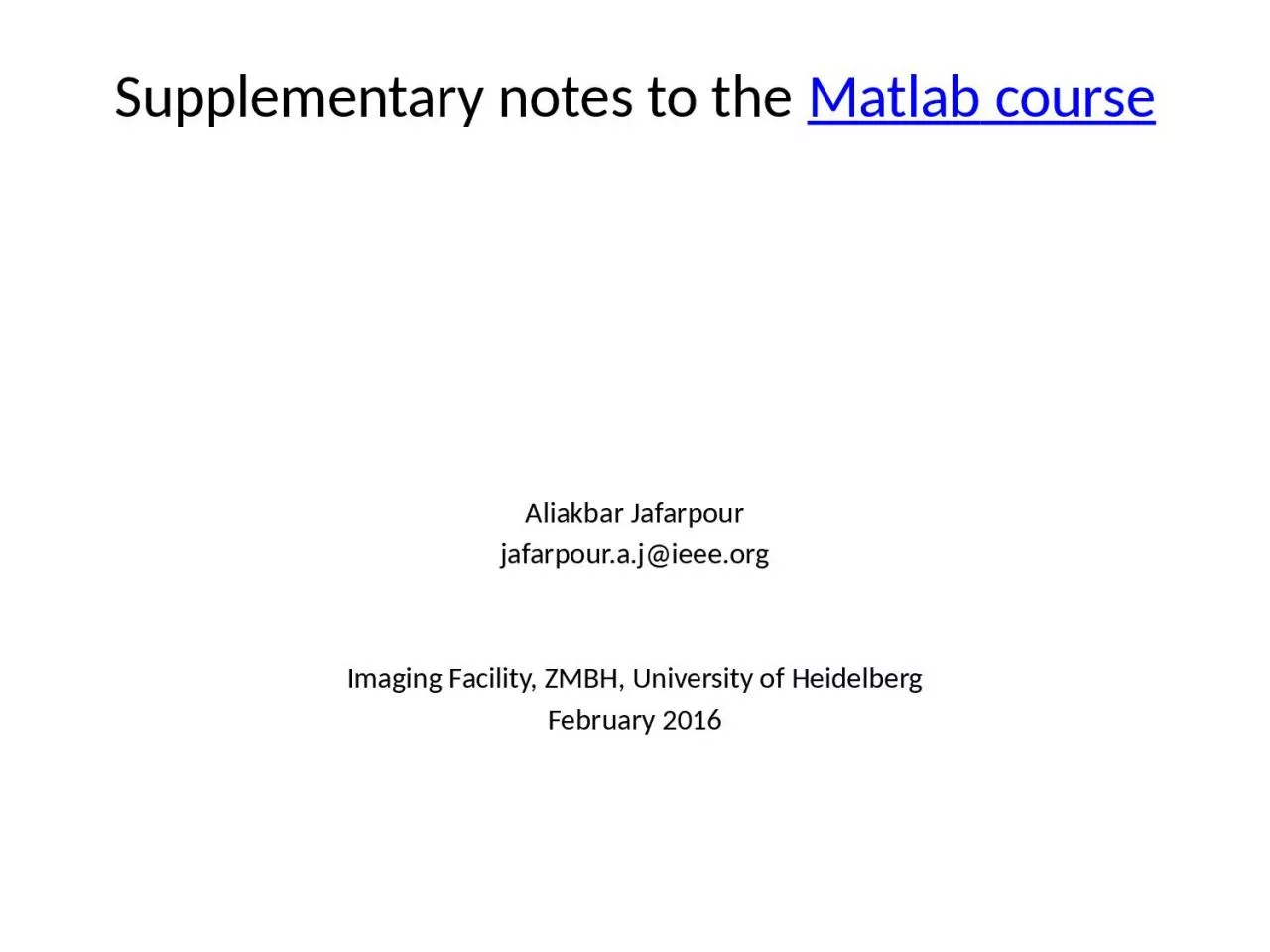

Imaging Facility ZMBH University of Heidelberg February 2016 Supplementary notes to the Matlab course There is no wrong question Please ask questions one doesnt lose face Copypasting programs ID: 1043068
Download Presentation The PPT/PDF document "Aliakbar Jafarpour jafarpour.a.j@ieee...." is the property of its rightful owner. Permission is granted to download and print the materials on this web site for personal, non-commercial use only, and to display it on your personal computer provided you do not modify the materials and that you retain all copyright notices contained in the materials. By downloading content from our website, you accept the terms of this agreement.
1. Aliakbar Jafarpourjafarpour.a.j@ieee.orgImaging Facility, ZMBH, University of HeidelbergFebruary 2016Supplementary notes to the Matlab course
2. There is no wrong question.Please ask questions; one doesn’t lose face.Copy-pasting programsQuick reminderWeb browserCmd + A (select all)Cmd + C (copy)MatlabCmd + A (select all in an open file), orCmd + N (new file creation)Cmd + V (paste)
3. What the goals are not Complete coverage of programming concepts/tools in MatlabWriting advanced Matlab programsReview of the mathematics behind MatlabCoverage of biological concepts, experiments, or data interpretationWhat the goals are Bypassing unnecessary details in an application-oriented approachEnhancing analytical thinking and objective formulation of problemsProviding a solid background/vision for those willing to dive deeper into programming/analysisGoals
4. Biological knowledgeTechnical knowledgeExperimentDataResults{ …, This course, …}The role of data analysisInterestingClarity, objectivity, interest, …?Hey programmer Pal,What do we see?
5. Running different versionsObservation of changes from one version to the nextNoticing the brief notes about such changes(One’s own) Concluding notesIndividual new commandsAmbiguities and uncertaintiesHypotheses and testing themOfficial documentation of the commandsSimilar commands Using exercises
6. From raw (2D or 3D) data to 2D screen124454444566346799467997677787667767Raw (2D) data2D Screen1244544445663467994679976777876677672D ScreenRaw (3D) dataRenderingRendered dataMapping between 2D screen (pixels) and the 3D scene (objects, illumination, …)
7. Common (surface) renderingRay-casting: sending pixels to sceneRasterization: projecting scene to pixels (used by computer graphics cards)Ray-tracing: Ray-casting + accurate scene illumination (high-quality “realistic 3D”)Volume rendering implementationsImageJ 3D ViewerX3DOM (1, 2) and Web3D ConsortiumVolume ray-castingAppendix 4: Rendering
8. Z-stack (confocal microscopy) vs. tomographic imaging (CT scan …)2D Projection1D RotationxyzZ Stack Stack” (tomograms) 3D Imaging=
9. Key-words and referencesPDB IDElectrostatic potentialResolution distanceViruses with icosahedral symmetryInternational Tables for Crystallography3D Imaging ModalityDatabaseVisualizationProgramReconstructionProgramMeasuredQuantityX-ray CrystallographyEDS (PDB)Chimera, …CCP4 , XDS , …Electron densitySingle-Particle Electron Microscopy (EM)EMDBChimera , …SPIDER, EMAN , …Electrostatic potentialElectronsX-ray“Fourier Transform”2D Scattering Pattern3D Object2D Projection3D data in Structural BiologyTakehome messagesData: Available, free, and reliableVisualization tool: UCSF Chimera …Visualization results + biological interpretation: Detailed and well-documented (in associated journal papers)
10. 1D Variations (1D Visualization)0D (point) contours1D Variations (2D Visualization)2D Variations (2D Visualization)1D (curve) contours2D Variations (3D Visualization)3D Variations (3D Visualization)2D (surface) contours3D Variations (in 4D Space)Isosurface visualization (of a z-stack)Putting “3D surface” into perspective Contours and variation/visualization dimensionsI = f1(x)I = f2(x,y)I = f3(x,y,z)Homework for volunteers!xIyxzyA Line in a single confocal imageA single confocal imageA confocal z-stack“3D surface”
11. Think about a (Matlab) program to analyze some of your data Write down what you wantWith informal language By using biological termsBy referring to biological background (concepts)By referring to biological background (people, institutions, publications)Write down what you wantWith informal languageWithout using biological termsWithout referring to biological backgroundWith very simple (not fancy) graphicsWith simple words (such as “first image”, “Intense spots”, “curve”, “object”, ….)(The same language that you like to be used by a [non-biologist] mathematician)Homework